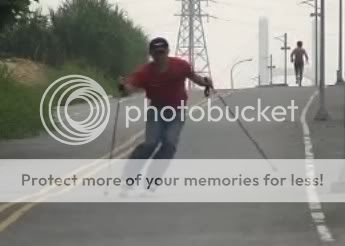The way I see it,pku 寫:I use poles to maintain my rymthm , timing and some times stop turning my upper body too much in short turns. I like skiing short turns.
"The parallel-skiing is based on the technique of parallel-turn. Due to the locked-heel bindings and stiff boots, parallel-turn has a more rigid structure than telemark-turn has. (Although less efficient, however, parallel-turn on loose-heel binding is the same as that of locked-heel binding.) In analyzing the parallel-turn techniques the skier finds that there are four definite phases to execute a turn: (1) pole-planting, (2) unweighting, (3) weight-shifting, and (4) traversing.
A parallel-turn begins at the end of the previous turn. The pole-planting marks the beginning of the turn. With the aid of the pole-planting, the unweighting follows. While unweighted, the weight is shifted from the downhill ski to the uphill ski and at the same time skis are pivoted into a new direction. By rolling the pressure off the uphill edges to the downhill edges, the traversing follows to finish the turn. If done in a precise and fluid manner, parallel-turn is a quick way to turn with little speed lost. However, it has its own share of problems.
In parallel-turn, poles are used as a timing device, and as a supporting device. However, used as a timing device, misusing a pole means a missed timing; used as a supporting device, miss-planting a pole costs the skier's balance.
The time and place they fail are usually when the skier needs them the most. In order to avoid such failures, the skier needs to pay attention to where and when the skier uses poles. While the skier needs all the concentration to ski the terrain ahead for an all-out performance, pole-planting diverts much needed concentration.
Meanwhile, carrying poles creates an aerodynamic drag which slows us down; during a turn, the three foot pole creates a undesirable leverage on the outside pole which holds the skier's outside shoulder back also delays turning, further contributes undesirable side effect. Poles have their places in downhill skiing, however, at times, they create more problems than they solve. the skier pays a high price for carrying poles.
Pole-planting also restricts down-unweighting; the natural consequence is up-unweighting. Up-unweighting fights against gravity, thus reduces momentum which reduces speed. Moving the body up and down also increases fatigue, and contributes instability in turning.
Weight-shifting can be executed only after first two steps are executed properly; otherwise, the skier would not have the balance to continue the turn, and weight-shifting would only compound the problem. Pivoting creates skidding, and skidding further reduces the speed.
After the weight is shifted to the uphill ski, the traversing begins by rolling the pressure off the uphill edges, and resetting it on the downhill edges (which are now the uphill edges in the coming turn) to change the direction of travel. Because the edge pressure is directly tight to the quality of the turn, the switch has to be decisive and precise.
During a turn, due to the skier's maneuvering pressure, the skis are arced upward. It is such arc that generates the turning force which causes the ski to change direction. If the skier relaxes the pressure on a ski, the ski bounces back, the arc is reduced, which changes the turning dynamic, the skier slows down and becomes unstable. The skier suffers a poor quality turn. If the skier maintains the pressure on the ski, the turning dynamic locks the skier in place, which makes fine directional adjustment difficult. The traversing needs to be executed more precisely still, so the skier will be able to arrive to a proper position to initiate the next turn. Due to the timing requirement on each phase, the whole turning sequence is complicated and difficult to execute properly. Parallel-turn leaves more to be desired.
Clearly, the culprit is the pole-planting. Due to the timing requirement of the pole-planting and the consequence that follows, the pole-planting depicts a very rigid structure for the skier to follow. To free the skier from such a restriction, a new style of skiing is evolved-Tai Chi Skiing. Tai Chi Skiing skis without poles. By not carrying poles, the skier is freed from the structure that is imposed on by the pole-planting; the skiing starts to lose its form and begins a new transformation."
http://www.taomartialarts.com/ski/ski_prin_tech.html
The idea is not we switch the techniques but one person—you—to do both ways to find out, except in serious mogul and extreme skiing/steep, you'll find that ski without poles is easier, quicker turns, and faster speed.So when we meet, we can make some runs together that you ski with poles and I ski without poles and see what will be the outcome.
Oops, if you only do moguls, that's a different story.
:)
IS


 我說的是看著路,想著要滑行的路線,身體自然就會配合適時適當的動作了,不用再花腦筋思考身體的動作,這樣臨時反應才會快。
我說的是看著路,想著要滑行的路線,身體自然就會配合適時適當的動作了,不用再花腦筋思考身體的動作,這樣臨時反應才會快。

 如果大師能滑的比我更好,我給的掌聲會更大
如果大師能滑的比我更好,我給的掌聲會更大 
